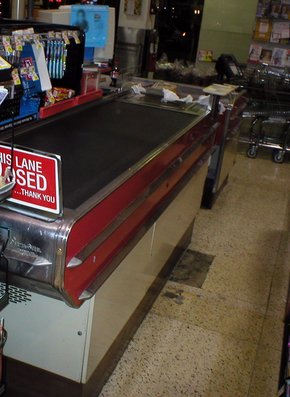Point of sale
|
|
- POS must not be confused with EFT/POS and POS Terminal used in Electronic payment
POS or PoS is an acronym for point-of-sale (or point of service or point of purchase). This can mean a retail shop, a checkout counter in a shop, or a variable location where a transaction occurs.
| Contents [hide] |
Traditional stores
A check-out counter, checkstand, or checkout is the aisle where people place items they have chosen to purchase from a store, such as a supermarket or department store. This is typically a long counter, which usually contains a moving belt or sometimes a rotating carousel, and a photocell to stop it when items reach the end. The cashier rings up each item on the cash register and obtains the total. The items are placed in bags and the customer can take them after paying.
Marketers design special advertisements, called point-of-sale displays that are typically found at or near a checkout counter. These displays are frequently designed to stimulate impulse purchases, (especially of items that children will beg parents for).
Point-of-sale technology
The term is often used in connection with hardware and software for checkouts, and in the case of variable locations, with wireless systems.
POS systems evolved from the mechanical cash registers of the first half of the 20th century. Examples of this type of register were the NCR registers operated by a crank and the Burroughs registers which were opperated by a lever. These registers recorded data on journal tapes or paper tape and required an extra step to transcribe the information into the retailer's accounting system. The next step in evolution was to move to operation by electricity. An example of this type of register was the NCR Class five cash register. In 1973 new registers that were driven by computers were introduced. Such as the IBM 3653 Store System and the NCR 2150. Other computer based manufacurers were Regitel, TRW, and Datachecker. 1973 also brought about the introduction of the UPC/EAN barcode readers on the POS systems. In 1986 the POS systems became based on PC technology with the introduction of the IBM 4683. By 2005 the retail POS systems are among the most sophisticated and powerful computer networks in commercial use.
POS Software Systems
POS is an acronym for Point of Sale. POS software enables an efficient and automated recording of the data that comprises a business transaction when the sale of goods or services to the customer occurs.
POS software often feeds data to other software modules to create a more comprehensive and useful array of software tools, including merchandizing, forecasting, accounting and inventory-control. Some POS software packages feature these functions fully integrated.
The First POS software
The early electronic cash registers (ECR) were programed in propietary software and were very limited in function and communications capability. In August of 1973 IBM announced the IBM 3650 and 3660 Store Systems that were, in essence, a mainframe computer packaged as a store controler that could control 128 IBM 3653/3663 Point os Sale Registers. This system was the first commercial use of Client Server technology, peer to peer communications, Local Area Network (LAN) simultanious backup, and remote Initialization. By mid 1974 it was installed in Pathmark Stores in New Jersey and Dillards Department Stores.
Programability allowed retailers to be more creative. In 1979 Gene Mosher's Old Canal Cafe in Syracuse, New York was using POS software written by Mosher that ran on an Apple to take customer orders at the restaurant's front entrance and print them in the restaurant's kitchen. In that novel context customers would often procede to their tables to find their food waiting for them! This software included real time labor and food cost reports.
In 1985 Mosher introduced the first touchscreen-driven, color graphic, POS interface. This software ran on the Atari ST, the world's first consumer-level color graphic computer. By the end of the 20th century Mosher's promotion of his unpatented software paradigm had resulted in its worldwide adoption by cash register manufacturers and other POS software developers as the de facto standard for point of sale software systems.
POS Hardware Interface Standarization
Initiatives to standardize development of computerized POS systems have been made to alleviate interconnecting POS devices. Two such initiatives are OPOS and JavaPOS, both conforming to the UnifiedPOS standard. A standard led by The National Retail Foundation. OPOS was the first commonly adopted standard and was initiated by Microsoft, NCR Corporation, Epson and Fujitsu-ICL. OPOS is a COM based interface compatible with all COM enabled programming languages for Microsoft Windows. OPOS was first released in 1996. JavaPOS was initiated by Sun Microsystems, IBM, and NCR Corporation in 1997 and first released in 1999. JavaPOS is for Java what OPOS is for Microsoft Windows and thus largely platform independent.
External links
- POS Standards overview (http://www.monroecs.com/posstandards.htm) at Monroe Consulting Services.
- Unified POS (http://www.nrf-arts.org/UnifiedPOS/default.htm) at The Association for Retail Technology Standards
- JavaPOS (http://www.javapos.com/)de:Kassenarbeitsplatz

